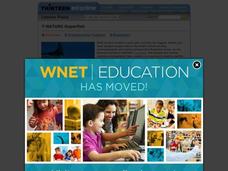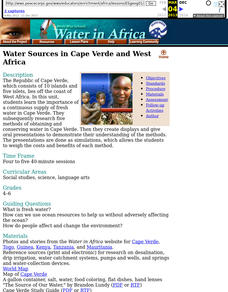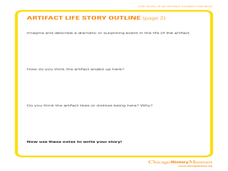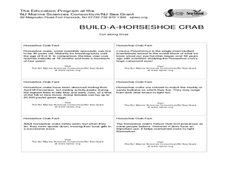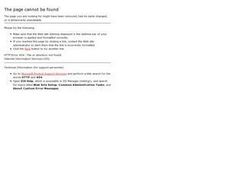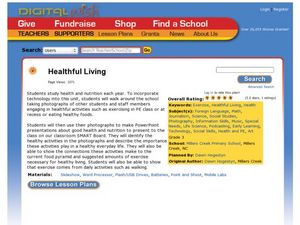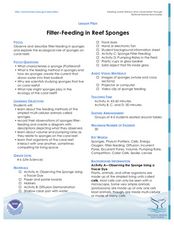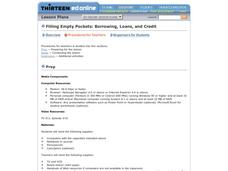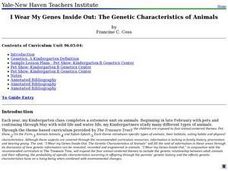Curated OER
Crude Conversation
Students analyze text and maps in determining the effect the world's energy resources have on human society, and make charts illustrating at least three ways each resource makes life easier for human society.
Curated OER
Get in the Newspaper Habit
Dive into journalism with your high schoolers! The resources provided here will help your learners write unbiased, clear, and succinct newspaper articles. First they spend time sifting through stacks of articles, filling out a graphic...
Curated OER
Nature Superfish
Learners study the behavior or ocean animals called billfish. For this life science lesson, students create their own documentary about a local animal. They share their videos with the entire school.
Curated OER
Water Sources in Cape Verde and West Africa
Young explorers study the scarcity and importance of a continuous supply of fresh water in Cape Verde. They research the five main ways that fresh water is obtained in these countries. Each research group prepares a presentation, and...
EduGAINs
Making Savvy Consumer Choices
It's never too early to learn about grocery budgeting. Middle schoolers delve into the world of consumer math with a lesson plan that focuses on both healthy choices and real-world math applications. Groups work together to form a...
Curated OER
Something's Fishy
Learners study fish habits and traits. In this marine life lesson, students complete four learning centers of a fish memory game, a fish habitat study, draw and glue fish craft activity, and a fish read-a-thon. Learners complete their...
Curated OER
Life Story of an Artifact
Students write about an artifact that they are studying. In this artifacts lesson plan, students analyze details of the artifact and answer short answer questions about it.
Curated OER
Traveler's Trunk
Students analyze and interpret artifacts from the 1920s and explore the Great Migration. In this 1920s history lesson, students review background information about the Great Migration and use artifacts to study history of Chicago....
Curated OER
Creating Animal Prints
Students investigate the habits of animals by studying their prints. In this animal life instructional activity, students investigate the different types of tracks left from animals by researching the Internet. Students...
Curated OER
Health Fair
Students identify and research the aspects of a healthy lifestyle and create a Health Fair with the information. In this healthy living lesson, students research a topic about healthy living. Students then create a health fair using...
Curated OER
Food Challenge
Students identify poor eating habits and create a plan to overcome them. In this eating habits lesson, students identify four eating habits they have and research the implications of poor eating habits. Students find healthy alternatives...
Curated OER
Build-A-Horseshoe Crab
Students discover many facts about horseshoe crabs. Students identify the main body parts of horseshoe crab. They explore the habits of the horseshoe crab and their importances to the ecosystem. Adaptations for younger students are...
Curated OER
Invertebrates
Students identify insect body parts and look for local insect life. They create an insect using recycled material and design a classroom mural with bug facts. They study Monarch butterflies and dragonflies.
Curated OER
Shopping Basket
Students study the origins of the items in a typical shopping baskets. They investigate how raw materials are processed into products that are purchased when shopping.
Curated OER
Dinosaurs 1: Where Are the Dinosaurs?
Young scholars explore dinosaurs. In this dinosaur identification instructional activity, students watch video clips for different dinosaurs from the Discovery Kids website. Young scholars discuss the clips with their teacher. Students...
Curated OER
Foods and Nutrition
Students study nutrition, healthy choices for food, and ways to prepare food. They review the Food Guide Pyramid and play Nutriend Tic Tac Know to select healthy foods. As a group they make pretzels, Mystery Muffins, soda, and play the...
Curated OER
The Nesting Habits of Folders
Students create an organized web of nested grade level folers. Within each grade level folder, they create a Language Arts/Social Studies folder and a Math/Science folder. All folders be color coded.
Curated OER
Healthful Living
Third graders take digital pictures of people in healthful activities. In this technology health activity, 3rd graders use their digital pictures to create a healthy living multimedia presentation.
Curated OER
Filter Feeding in Reef Sponges
Learners investigate the role of sponges in our oceans. In this biology lesson, students create a diagram visualizing how sponges bring food into their bodies through a filtering process. Learners discuss the connections...
Curated OER
What are Hunger and Malnutrition and Who Are the Hungry?
Students discuss the main functions of food and how eating the right foods is important for a healthy lifestyle. Using the internet, they research those who are at the highest risk for hunger and how those countries are trying to solve...
Curated OER
FILLING EMPTY POCKETS: BORROWING, LOANS AND CREDIT.
Students learn that maintaining financial security takes a good math understanding. In this lesson, students apply mathematical formulas to make important financial decisions like getting the right loan to buy a house, decide which...
Curated OER
The Vikings of Scandinavia
Students become familiar with who the Vikings were and what they accomplished. In this Vikings lesson, students locate the Scandinavian countries. Students will record information about the Vikings in a Viking notebook. Students will...
Curated OER
Animal Characteristics
Students investigate the characteristics of animals by creating a chart. For this animal life lesson, students create a KWL chart listing all the different animals a class can name. Students take a field trip to a science facility to get...
Curated OER
I Wear My Genes Inside Out: The Genetic Characteristics of Animals
Young scholars create mixed breed dogs using paper illustrations of various breeds. They label dogs created by students using the Genetics Center and discuss the aspects of genetics that affect the outcome of the various projects.


